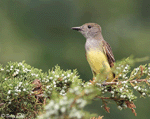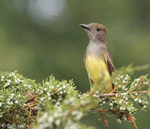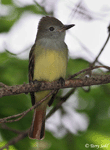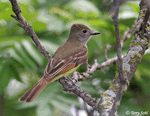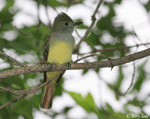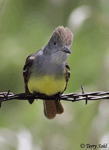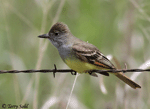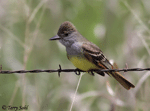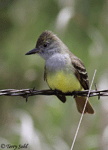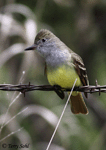| Length: 8.5 inches | Wingspan: 12 - 14 inches | Seasonality: Summer |
| ID Keys: Bright yellow belly and undertail coverts, olive-green upperparts and head, gray throat and upper breast, thick black bill, shaggy gray crest. | ||
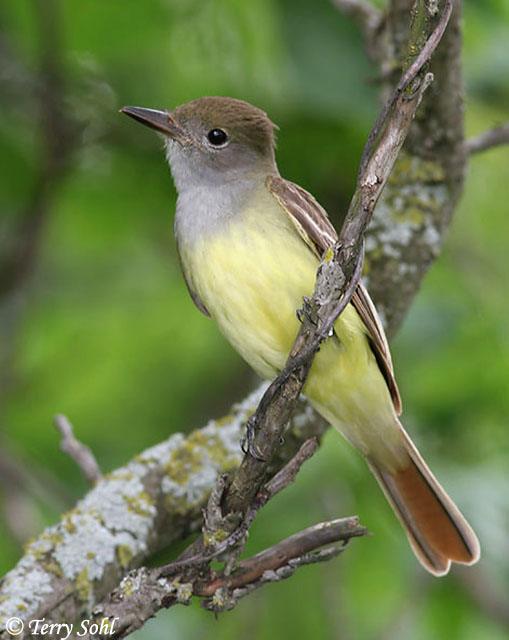 The Great Crested Flycatcher
is one of the most colorful of flycatchers found in South Dakota, with a bright lemon-yellow
belly, a brownish crest, and rich cinnamon-brown coloring on their wings and
underside of the tail. Unfortunately, they are most often found in the treetops and are
easier to hear than to see. They are sometimes fierce when defending their
territories, and will go as far as pulling feathers out of birds who dare to
intrude into their space.
The Great Crested Flycatcher
is one of the most colorful of flycatchers found in South Dakota, with a bright lemon-yellow
belly, a brownish crest, and rich cinnamon-brown coloring on their wings and
underside of the tail. Unfortunately, they are most often found in the treetops and are
easier to hear than to see. They are sometimes fierce when defending their
territories, and will go as far as pulling feathers out of birds who dare to
intrude into their space.
Habitat:
During the summer breeding season, found in deciduous or mixed forests, avoiding pure conifer forests. They can be found nearly anywhere within the forest habitat, from the deep forest to forest edges and clearings. Winters in the tropics around second-growth forest or along woodland edges.
Diet:
Primarily feeds on flying insects. Will also eat other insects and spiders, fruits, berries, and occasionally small lizards.
Behavior:
Great Crested Flycatchers forage by flycatching...flying out from a perch to catch flying insects. They are usually found high in the tree canopy, a habit that when coupled with their often vocal nature, makes them a species that is more often heard than seen.
Nesting:
Late May through June. Great Crested Flycatchers are cavity nesters, primarily using natural cavities and old woodpecker holes in trees. They've also been known to use a wide variety of cavities in human structures and objects. The female builds most of the nest, forming a base at the floor of the cavity and then building a cup-shape nest that could consist of an incredibly wide array of materials, including grasses, weed-stems, rootlets, twigs, hair, feathers, moss, lichen, and various man-made objects. It's often been noted that Great Crested Flycatcher nests will also include a shed snakeskin if they can find one. The female lays between 4 and 8 eggs, and both parents help to incubate them. The young hatch after about 2 weeks, and then fledge from the nest another 2 weeks after hatching.
Song:
The call of a Great Crested Flycatcher is a strong musical wheep whistling. The song consists of a series of similar sounding notes, but typically with a two-part sound to each note, with crisp whistling that starts strong and transitions to a lower pitch.
- Click here to hear the song of a Great Crested Flycatcher1
- Click here to hear the call of a Great Crested Flycatcher2
Migration:
Summers in the eastern half of the United States and southeastern Canada. Winters in Mexico southward through Columbia, with smaller numbers wintering in southern Florida.
Interactive eBird Map:
Click here to access an interactive eBird map of Great Crested Flycatcher sightings
Similar Species:
Great Crested Flycatchers are similar in overall appearance to multiple other flycatcher species. The three closest relatives below are mostly birds of the southwestern US and points south, but there are other "yellow-bellied" flycatchers even here in South Dakota that could cause confusion.
- Ash-throated Flycatcher - Ash-throated Flycatchers have a very broad range in the western US and down through the southern Great Plains (the latter of which may bring them into contact with Great Crested Flycatchers). They're less colorful than a Great Crested Flycatcher, with a similar overall color scheme, but with less extensive and less bright yellow on the belly.
- Dusky-capped Flycatcher - Dusky-capped Flycatchers have a limited US range, typically only reaching the US in summer in far southern Arizona and New Mexico. They are paler than a Great Crested Flycatcher, with a less colorful yellow belly.
- Brown-crested Flycatcher - Brown-crested Flycatchers are mostly birds of more tropical climates, but they reach the US in summer in parts of the far southwestern US and far southern Texas. They are less colorful than a Great Crested Flycatcher, with a paler yellow on the bellow, and less extensive rusty brown on the underside of the tail. They also appear more pale on the head and breast than a Great Crested Flycatcher.
- Western Kingbird - Western Kingbirds are the one of this list that pose the biggest identification challenge in South Dakota, as they are found throughout the state in summer. Western Kingbirds have a brighter yellow belly than a Great Crested Flycatcher, and lack the brownish crown and rusty tones on the wings and tail.
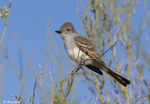 |
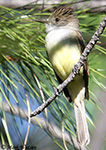 |
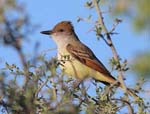 |
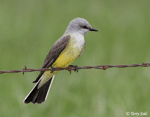 |
| Ash-throated Flycatcher | Dusky-capped Flycatcher | Brown-crested Flycatcher | Western Kingbird |
Conservation Status:
Systematic surveys over the last few decades show stable populations overall. They are found across a very broad geographic area, and are common in parts of that range. The IUCN considers the Great Crested Flycatcher to be a species of "Least Concern".
Further Information:
- Patuxent Bird Identification InfoCenter, Great Crested Flycatcher
- Great Crested Flycatcher - Audubon Guide
- WhatBird - Great Crested Flycatcher
Photo Information:
July 4th, 2006 -- Big Sioux Rec. Area near Brandon -- Terry Sohl
Additional Photos:
Click on the image chips or text links below for additional, higher-resolution Great Crested Flycatcher photos.
Audio File Credits:
- 1Andrew Spencer. Recorded in Osceola County, Florida on May 21st, 2012. Original recording and information available from xeno-canto.
- 2Andrew Spencer. Recorded near Pipeline Road, Colon, Panama on March 19th, 2009. Original recording and information available from xeno-canto.
| Click on the map below for a higher-resolution view |
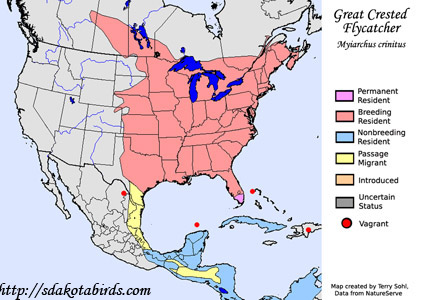 |
| South Dakota Status: Uncommon summer resident throughout most of the state, although less common in the western part of the state. |
Additional Great Crested Flycatcher Photos
Click for a higher-resolution version of these photos
